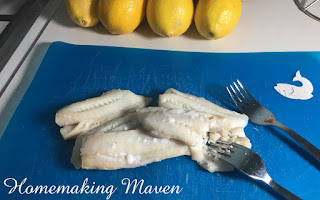It has been many many moons since I've written a blog post, but I have received many requests for recipes and downloadable or printable media that I create over on my YouTube channel.
So.
It's time to start writing again!
And for my first entry (in a very long time!) we are going to dive headlong into the world of bread!
I absolutely LOVE making bread. Which is a good thing because our family eats a lot of it! And not just because we like it, but because we recently expanded our family of 6 to a family of 7. Yes. We have a new addition name Magdalynn. She is lovely and beautiful (and you will likely see photos of her inserted at random as she is just too cute not to photograph!) and we are so happy to have her in our family.
But feeding our enlarging family can be a challenge!
Thankfully this bread recipe is simple, costs very little and makes four loaves at a time. You can divide the recipe to create only one loaf or double it to create eight (if you have the space for all those loaves!), You can also substitute grains and add more grains if you 'd like. The recipe is flexible. Just the way I like it! *smile*
 |
| Watching the yeast proof |
To proof the yeast, mix the dough, allow it to rise and bake the bread does take time. It's best to make bread when you know you'll be home. To save a small bit of time, I place my loaves in the oven to bake before even turning it on. Yes! I preheat the oven with the loaves inside!! Crazy but true. I find I get better loaf baking by having them already in the oven as it heats up.
 |
| The bread is in the oven! |
Can you still bake bread if you have a very busy schedule that keeps you out of the house most of the day? Absolutely! I have started bread as late as 6 pm. It'll still be ready before my bedtime at 1030 pm. And who wouldn't want fresh bread for breakfast the next morning!??!
 |
| Waiting for the second rise |
It's all worth it in the end. You'll get lovely hearty loves that will satisfy hungry tummies and picky tastebuds. Your home will also be filled with the smell of fresh baked bread. Is there a better smell than that? And if you top that fresh bread with homemade jam? Yummmmm!!! Just heaven!
 |
| Four lovely loaves |
Without further ado, here's how to create my Multi-Grain Bread:
Multi-Grain Bread
4 cups Warm Water (divided)
2 tbsp Active Dry Yeast
2 tbsp Salt
4 tbsp Oil (I use canola)
1/2 cup Bulgar
4 cups Whole Wheat Flour
2 cups All-Purpose Flour
1 cup Oats
3-5 cups All-Purpose Flour (amount will depend on consistency of the dough)
1. Using a Kitchen Aid mixer with hook attachment, divide the warm water between the bowl of the mixer and a second bowl.
2. Add the yeast to the mixer bowl and let it proof for at least 5 minutes. Add the salt and oil to the second bowl.
3. Pour the bulgar into a third smaller bowl and cover with water (any temperature) and allow it to sit 10 minutes.
4. Pour the salt water from the second bowl in the yeast water of the mixer bowl. Add the whole wheat flour and 2 cups of the all-purpose flour.
5. Optional: Turn on the oven (150 F or lowest setting) and allow it to warm.
6. Turn the mixer on, using the lowest setting. Allow it to mix until the flour and water are well combined.
7. Turn off the mixer. Scrape sides of mixing bowl if needed. Drain and add the bulgar to the dough. Add the oats. Add 3 cups of all-purpose flour. Turn on the mixer (to the lowest setting) and allow all ingredients to combine well.
8. Turn off mixer and scrape sides of mixing bowl if needed. Add more flour if needed. Dough is done mixing once it forms into a ball and pulls away from the sides of the mixing bowl.
9. Remove mixing bowl from mixer. Cover dough with a damp towel and let rise 1-2 hours depending on room temperature. (Option: Turn off oven and let dough rise in oven for colder climates/seasons)
10. Grease or line loaf pans with parchment paper, lard or shortening.
11. Spread a thin layer of oil over counter (I use canola) and remove risen dough from mixer bowl. Scrape out any dough stuck to the side of the bowl with a spatula. Flatten the dough on the oiled surface into a large oval.
12. Cut the dough into 4 equal pieces. Roll the dough into logs, pinching and tucking the rolled edge on the bottom of the log. Place each rolled log into it's own loaf pan.
13. Allow the loaves to rise a second time (Option: Rise in oven a second time for cold climate/seasons) for 1 hour.
14. Place all loaf pans in the oven. Heat oven to 350 F with loaves inside. Set timer for 35 minutes.
15. Once baked, allow loaves to sit for 5 minutes to cool and shrink. Then simply flip over loaf pans to remove bread loaf. (Do not let the loaf to cool in it's pan. It will get a soggy bottom!) Allow loaf to cool completely on a cooling rack before placing it in a bread bag. Loaf can be kept on counter for 1 week, in the fridge for 2 weeks or in the freezer for 2 months.














